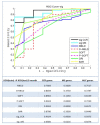Crossroads in Liver Transplantation: Is Artificial Intelligence the Key to Donor-Recipient Matching?
- PMID: 36556945
- PMCID: PMC9783019
- DOI: 10.3390/medicina58121743
Crossroads in Liver Transplantation: Is Artificial Intelligence the Key to Donor-Recipient Matching?
Abstract
Liver transplantation outcomes have improved in recent years. However, with the emergence of expanded donor criteria, tools to better assist donor-recipient matching have become necessary. Most of the currently proposed scores based on conventional biostatistics are not good classifiers of a problem that is considered "unbalanced." In recent years, the implementation of artificial intelligence in medicine has experienced exponential growth. Deep learning, a branch of artificial intelligence, may be the answer to this classification problem. The ability to handle a large number of variables with speed, objectivity, and multi-objective analysis is one of its advantages. Artificial neural networks and random forests have been the most widely used deep classifiers in this field. This review aims to give a brief overview of D-R matching and its evolution in recent years and how artificial intelligence may be able to provide a solution.
Keywords: artificial intelligence; artificial neural networks; deep learning; donor–recipient matching; liver transplantation outcomes; random forest.
Conflict of interest statement
The authors declare no conflict of interest.
Figures




Similar articles
-
Artificial Intelligence in Liver Transplantation.Transplant Proc. 2021 Dec;53(10):2939-2944. doi: 10.1016/j.transproceed.2021.09.045. Epub 2021 Nov 2. Transplant Proc. 2021. PMID: 34740449
-
Artificial intelligence and liver transplantation: Looking for the best donor-recipient pairing.Hepatobiliary Pancreat Dis Int. 2022 Aug;21(4):347-353. doi: 10.1016/j.hbpd.2022.03.001. Epub 2022 Mar 8. Hepatobiliary Pancreat Dis Int. 2022. PMID: 35321836 Review.
-
Machine-learning algorithms for predicting results in liver transplantation: the problem of donor-recipient matching.Curr Opin Organ Transplant. 2020 Aug;25(4):406-411. doi: 10.1097/MOT.0000000000000781. Curr Opin Organ Transplant. 2020. PMID: 32487891 Review.
-
Artificial intelligence for predicting survival following deceased donor liver transplantation: Retrospective multi-center study.Int J Surg. 2022 Sep;105:106838. doi: 10.1016/j.ijsu.2022.106838. Epub 2022 Aug 24. Int J Surg. 2022. PMID: 36028137
-
Donor-recipient matching in adult liver transplantation: Current status and advances.Biosci Trends. 2023 Jul 11;17(3):203-210. doi: 10.5582/bst.2023.01076. Epub 2023 Jun 22. Biosci Trends. 2023. PMID: 37344395 Review.
Cited by
-
Predicting waitlist dropout in hepatocellular carcinoma: a narrative review.Transl Gastroenterol Hepatol. 2024 Aug 21;9:72. doi: 10.21037/tgh-24-24. eCollection 2024. Transl Gastroenterol Hepatol. 2024. PMID: 39503025 Free PMC article. Review.
-
An In-depth overview of artificial intelligence (AI) tool utilization across diverse phases of organ transplantation.J Transl Med. 2025 Jun 18;23(1):678. doi: 10.1186/s12967-025-06488-1. J Transl Med. 2025. PMID: 40533820 Free PMC article. Review.
-
Machine learning in liver surgery: Benefits and pitfalls.World J Clin Cases. 2024 Apr 26;12(12):2134-2137. doi: 10.12998/wjcc.v12.i12.2134. World J Clin Cases. 2024. PMID: 38680268 Free PMC article.
-
Smart match: revolutionizing organ allocation through artificial intelligence.Front Artif Intell. 2024 Feb 28;7:1364149. doi: 10.3389/frai.2024.1364149. eCollection 2024. Front Artif Intell. 2024. PMID: 38481822 Free PMC article. Review.
References
-
- MacConmara M., Hanish S.I., Hwang C.S., De Gregorio L., Desai D.M., Feizpour C.A., Tanriover B., Markmann J.F., Zeh H., III, Vagefi P.A. Making Every Liver Count: Increased Transplant Yield of Donor Livers Through Normothermic Machine Perfusion. Ann. Surg. 2020;272:397–401. doi: 10.1097/SLA.0000000000004198. - DOI - PubMed
Publication types
MeSH terms
Grants and funding
LinkOut - more resources
Full Text Sources
Medical

